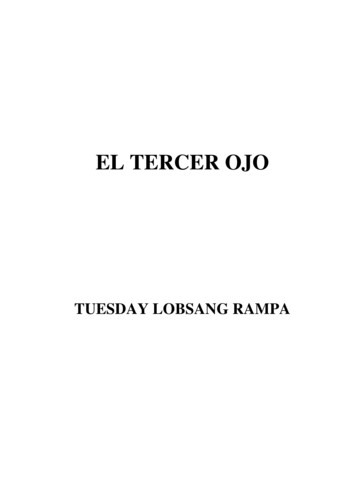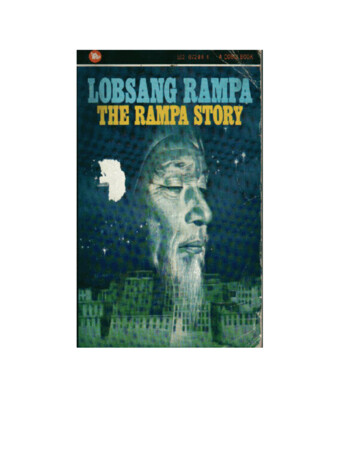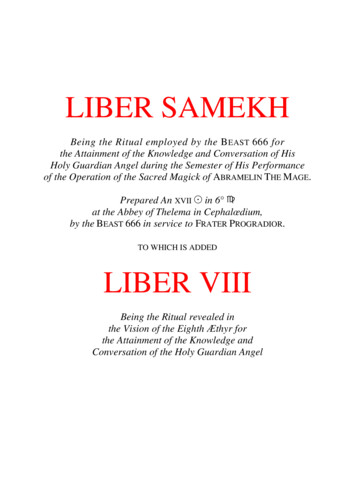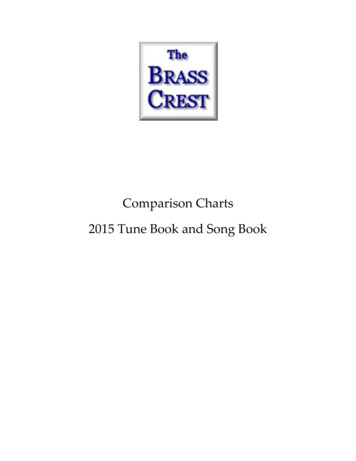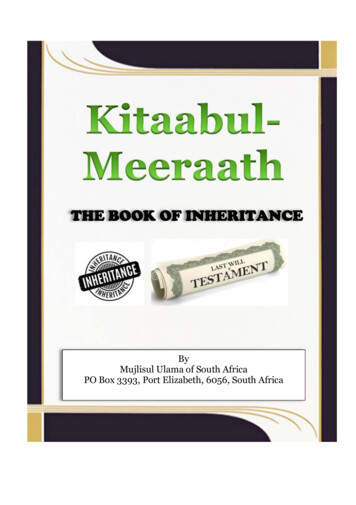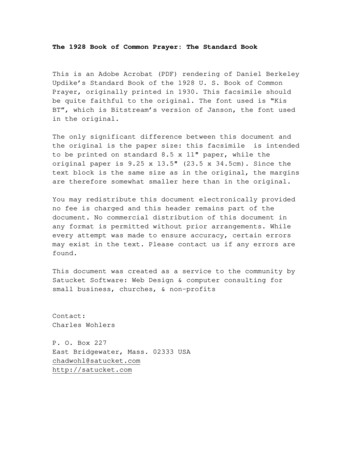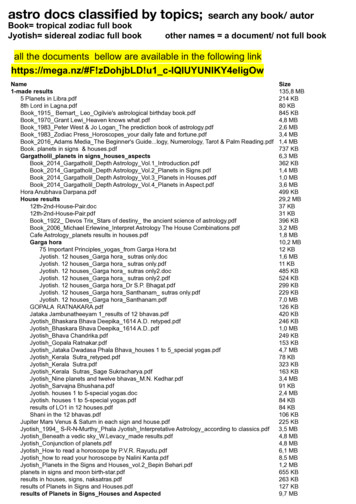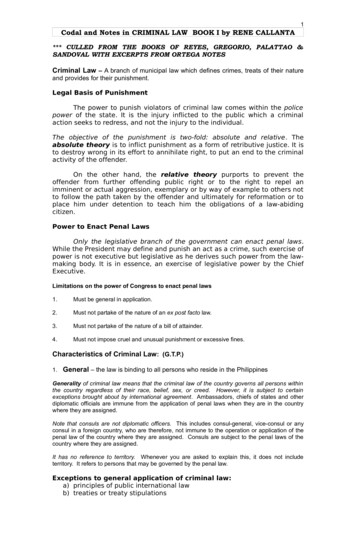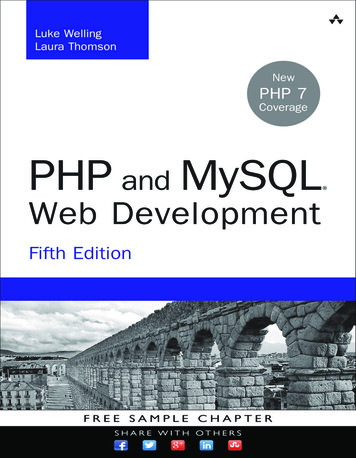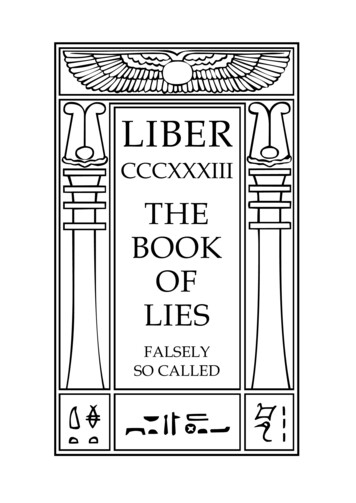
Transcription
LIBERCCCXXXIIITHEBOOKOFLIESFALSELYSO CALLED
First published London: E.J. Wieland, 1913.Second edition with commentaryIlfracombe: Haydn Press, 1952This electronic edition issued by Celephaïs Pressfrom somewhere beyond the Tanarian Hillsand manifested in the waking worldin Leeds, Yorkshire, England.Original key entry by Frater E.A.D.N.Formatting and further proofreadingby Frater Lege Iudica Atque RideLast revised 17.07.2004.(c) Ordo Templi OrientisJAF Box 7666New YorkNY 10116USA.
THE BOOK OF LIESWHICH IS ALSO FALSELYCALLEDBREAKSTHE WANDERINGS OR FALSIFICATIONSOF THE ONE THOUGHT OFFRATER PERDURABO(Aleister Crowley)WHICH THOUGHT IS ITSELFUNTRUEA REPRINTwith an additional commentary to each chapter.“Break, break, breakAt the foot of thy stones, O Sea !And I would that I could utterThe thoughts that arise in me!”Celephaïs PressUlthar - Sarkomand - Inquanok - Leeds2004
COMMENTARY (Title Page)The number of the book is 333, as implying dispersion, so as tocorrespond with the title, “Breaks” and “Lies”.However, the “one thought is itself untrue”, and therefore itsfalsifications are relatively true.This book therefore consists of statements as nearly true as ispossible to human language.The verse from Tennyson is inserted partly because of the pun on theword “break”; partly because of the reference to the meaning of thistitle page, as explained above; partly because it is intensely amusing forCrowley to quote Tennyson.There is no joke or subtle meaning in the publisher’s imprint.
A A Publication in Classes C and DOfficial for the Grade of Babe of the Abyss
?
!
ΚΕΦΑΛΗ Η ΟΥΚ ΕΣΤΙ ΚΕΦΑΛΗO!1THE ANTE PRIMAL TRIAD WHICH ISNOT-GODNothing is.Nothing Becomes.Nothing is not.THE FIRST TRIAD WHICH IS GODI AM.I utter The Word.I hear The Word.THE ABYSSThe Word is broken up.There is Knowledge.Knowledge is Relation.These fragments are Creation.The broken manifests Light.2THE SECOND TRIAD WHICH IS GODGOD the Father and Mother is concealed in Generation.GOD is concealed in the whirling energy of Nature.GOD is manifest in gathering: harmony: consideration: the Mirror of the Sun and of the Heart.THE THIRD TRIADBearing: preparing.Wavering: flowing: flashing.Stability: begetting.THE TENTH EMANATIONThe world.6
COMMENTARY (The Chapter that is not a Chapter)This chapter, numbered 0, corresponds to the Negative, which isbefore Kether in the Qabalistic system.The notes of interrogation and exclamation on the previous pagesare the other two veils.The meaning of these symbols is fully explained in “The Soldierand the Hunchback.”This chapter begins by the letter O, followed by a mark ofexclamation; its reference to the theogony of “Liber Legis” isexplained in the note, but it also refers to KTEIS PHALLOS andSPERMA, and is the exclamation of wonder or ecstasy, which is theultimate nature of things.NOTE(1) Silence. Nuit, O; Hadit; Ra-Hoor-Khuit, I.COMMENTARY (The Ante Primal Triad)This is the negative Trinity; its three statements are, in anultimate sense, identical. They harmonise Being, Becoming, NotBeing, the three possible modes of conceiving the universe.The statement, Nothing is Not, technically equivalent toSomething Is, is fully explained in the essay called Berashith.The rest of the chapter follows the Sephirotic system of theQabalah, and constitutes a sort of quintessential comment upon thatsystem.Those familiar with that system will recognise Kether, Chokmah,Binah, in the First Triad; Daath, in the Abyss; Chesed, Geburah,Tiphareth, in the Second Triad; Netzach, Hod and Yesod in theThird Triad, and Malkuth in the Tenth Emanation.It will be noticed that this cosmogony is very complete; themanifestation even of God does not appear until Tiphareth; and theuniverse itself not until Malkuth.The chapter many therefore be considered as the most completetreatise on existence ever written.NOTE(2) The Unbroken, absorbing all, is called Darkness.7
1ΚΕΦΑΛΗ ΑTHE SABBATH OF THE GOATO! the heart of N.O.X. the Night of Pan.PAN: Duality: Energy: Death.Death: Begetting: the supporters of O!To beget is to die; to die is to beget.Cast the Seed into the Field of Night.Life and Death are two names of A.Kill thyself.Neither of these alone is enough.8
COMMENTARY (A)The shape of the figure I suggests the Phallus; this chapteris therefore called the Sabbath of the Goat, the Witches’Sabbath, in which the Phallus is adored.The chapter begins with a repetition of O! referred to in theprevious chapter. It is explained that this triad lives in Night,the Night of Pan, which is mystically called N.O.X., and this Ois identified with the O in this word. N is the Tarot symbol,Death; and the X or Cross is the sign of the Phallus. For afuller com-mentary on Nox, see Liber VII, Chapter I.Nox adds to 210, which symbolises the reduction of dualityto unity, and thence to negativity, and is thus a hieroglyph ofthe Great Work.The word Pan is then explained, P, the letter of Mars, is ahieroglyph of two pillars, and therefore suggest duality; A, byits shape, is the pentagram, energy, and N, by its Tarotattribution, is death.Nox is then further explained, and it is shown that theultimate Trinity, O!, is supported, or fed, by the process ofdeath and begetting, which are the laws of the universe.The identity of these two is then explained.The Student is then charged to understand the spiritualimportance of this physical procession in line 5.It is then asserted that the ultimate letter A has two names,or phases, Life and Death.Line 7 balances line 5. It will be notice that thephraseology of these two lines is so conceived that the onecontains the other more than itself.Line 8 emphasises the importance of performing both.9
2ΚΕΦΑΛΗ ΑTHE CRY OF THE HAWKHoor hath a secret fourfold name: it is Do WhatThou Wilt.3Four Words: Naught—One—Many—All.Thou—Child!Thy Name is holy.Thy Kingdom is come.Thy Will is done.Here is the Bread.Here is the Blood.Bring us through Temptation!Deliver us from Good and Evil!That Mine as Thine be the Crown of the Kingdom,even now.ABRAHADABRA.These ten words are four, the Name of the One.10
COMMENTARY (B)The “Hawk” referred to is Horus.The chapter begins with a comment on Liber Legis III, 49.Those four words, Do What Thou Wilt, are also identifiedwith the four possible modes of conceiving the universe;Horus unites these.Follows a version of the “Lord's Prayer”, suitable to Horus.Compare this with the version in Chapter 44. There are tensections in this prayer, and, as the prayer is attributed toHorus, they are called four, as above explained; but it is onlythe name of Horus which is fourfold; He himself is One.This may be compared with the Qabalistic doctrine of theTen Sephiroth as an expression of Tetra- grammaton (1 plus 2plus 3 plus 4 10).It is now seen that this Hawk is not Solar, but Mercurial;hence the words, the Cry of the Hawk, the essential part ofMercury being his Voice; and the number of the chapter, B,which is Beth the letter of Mercury, the Magus of the Tarot,who has four weapons, and it must be remembered that thiscard is numbered 1, again connecting all these symbols withthe Phallus.The essential weapon of Mercury is the Caduceus.NOTE(3) Fourteen letters. Quid Voles Illud Fac. Q.V.I.F.196 142.11
3ΚΕΦΑΛΗ ΓTHE OYSTERThe Brothers of A A are one with the Mother ofthe Child.4The Many is as adorable to the One as the One is tothe Many. This is the Love of These; creationparturition is the Bliss of the One; coitiondissolution is the Bliss of the Many.The All, thus interwoven of These, is Bliss.Naught is beyond Bliss.The Man delights in uniting with the Woman; theWoman in parting from the Child.The Brothers of A A are Women: the Aspirants toA A are Men.12
COMMENTARY (Γ)Gimel is the High Priestess of the Tarot. This chapter givesthe initiated feminine point of view; it is therefore called theOyster, a symbol of the Yoni. In Equinox X, The Temple ofSolomon the King, it is explained how Masters of the Temple,or Brothers of A A have changed the formula of theirprogress. These two formulae, Solve et Coagula, are nowexplained, and the universe is exhibited as the interplaybetween these two. This also explains the statement in LiberLegis I, 28-30.NOTE(4) They cause all men to worship it.13
4ΚΕΦΑΛΗ PEACHESSoft and hollow, how thou dost overcome the hardand full!It dies, it gives itself; to Thee is the fruit!Be thou the Bride; thou shalt be the Mother hereafter.To all impressions thus. Let them not overcomethee; yet let them breed within thee. The least ofthe impressions, come to its perfection, is Pan.Receive a thousand lovers; thou shalt bear but OneChild.This child shall be the heir of Fate the Father.14
COMMENTARY ( )Daleth is the Empress of the Tarot, the letter of Venus, andthe title, Peaches, again refers to the Yoni. The chapter is acounsel to accept all impressions; it is the formula of theScarlet woman; but no impression must be allowed todominate you, only to fructify you; just as the artist, seeing anobject, does not worship it, but breeds a masterpiece from it.This process is exhibited as one aspect of the Great Work.The last two paragraphs may have some reference to the 13thAethyr (see The Vision and The Voice).15
5ΚΕΦΑΛΗ ETHE BATTLE OF THE ANTSThat is not which is.The only Word is Silence.The only Meaning of that Word is not.Thoughts are false.Fatherhood is unity disguised as duality.Peace implies war.Power implies war.Harmony implies war.Victory implies war.Glory implies war.Foundation implies war.Alas! for the Kingdom wherein all these are at war.16
COMMENTARY (E)He is the letter of Aries, a Martial sign; while the titlesuggests war. The ants are chosen as small busy objects.Yet He, being a holy letter, raises the beginning of thechapter to a contemplation of the Pentagram, considered as aglyph of the ultimate.In line 1, Being is identified with Not-Being.In line 2, Speech with Silence.In line 3, the Logos is declared as the Negative.Line 4 is another phrasing of the familiar Hindu statement,that that which can be thought is not true.In line 5, we come to an important statement, anadumbration of the most daring thesis in this book—Fatherand Son are not really two, but one; their unity being the HolyGhost, the semen; the human form is a non-essential accretionof this quintessence.So far the chapter has followed the Sephiroth from Ketherto Chesed, and Chesed is united to the Supernal Triad byvirtue of its Phallic nature; for not only is Amoun a PhallicGod, and Jupiter the Father of All, but 4 is Daleth, Venus, andChesed refers to water, from which Venus sprang, and whichis the symbol of the Mother in the Tetragrammaton. SeeChapter 0, “God the Father and Mother is concealed ingeneration.”But Chesed, in the lower sense, is conjoined toMicroprosopus. It is the true link between the greater andlesser countenances, whereas Daath is the false. Comparethe doctrine of the higher and lower Manas in Theosophy.The rest of the chapter therefore points out the duality, andtherefore the imperfection, of all the lower Sephiroth in theiressence.17
6ΚΕΦΑΛΗ FCAVIARThe Word was uttered: the One exploded into onethousand million worlds.Each world contained a thousand million spheres.Each sphere contained a thousand million planes.Each plane contained a thousand million stars.Each star contained a many thousand million things.Of these the reasoner took six, and, preening, said:This is the One and the All.These six the Adept harmonised, and said: This isthe Heart of the One and the All.These six were destroyed by the Master of theTemple; and he spake not.The Ash thereof was burnt up by the Magus intoThe Word.Of all this did the Ipsissimus know Nothing.18
COMMENTARY (F)This chapter is presumably called Caviar because thatsubstance is composed of many spheres.The account given of Creation is the same as that familiarto students of the Christian tradition, the Logos transformingthe unity into the many.We then see what different classes of people do with themany.The Rationalist takes the six Sephiroth of Microprosopus ina crude state, and declares them to be the universe. This follyis due to the pride of reason.The Adept concentrates the Microcosm in Tiphareth,recognising an Unity, even in the microcosm, but, qua Adept,he can go no further.The Master of the Temple destroys all these illusions, butremains silent. See the description of his functions in theEquinox, Liber 418 and elsewhere.In the next grade, the Word is re-formulated, for the Magusin Chokmah, the Dyad, the Logos.The Ipsissimus, in the highest grade of the A A , is totallyunconscious of this process, or, it might be better to say, herecognises it as Nothing, in that positive sense of the word,which is only intelligible in Samasamadhi.19
7ΚΕΦΑΛΗ ΖTHE DINOSAURSNone are They whose number is Six:5 else were theysix indeed.Seven6 are these Six that live not in the City of thePyramids, under the Night of Pan.There was Lao-tzu.There was Siddartha.There was Krishna.There was Tahuti.There was Mosheh.There was Dionysus.7There was Mahmud.But the Seventh men called PERDURABO; forenduring unto The End, at The End was Naughtto endure.8Amen.20
COMMENTARY (Z)This chapter gives a list of those special messengers of theInfinite who initiate periods. They are called Dinosaursbecause of their seeming to be terrible devouring creatures.They are Masters of the Temple, for their number is 6 (1 plus 2plus 3), the mystic number of Binah; but they are called“None”, because they have attained. If it were not so, theywould be called “six” in its bad sense of mere intellect.They are called Seven, although they are Eight, becauseLao-tzu counts as nought, owing to the nature of his doctrine.The reference to their “living not” is to be found in Liber 418.The word “Perdurabo” means “I will endure unto the end.”The allusion is explained in the note.Siddartha, or Gotama, was the name of the last Buddha.Krishna was the principal incarnation of the Indian Vishnu,the preserver, the principal expounder of Vedantism.Tahuti, or Thoth, the Egyptian God of Wisdom.Mosheh, Moses, the founder of the Hebrew system.Dionysus, probably an ecstatic from the East.Mahmud, Mohammed.All these were men; their Godhead is the result ofmythopœia.NOTES(5) Masters of the Temple, whose grade has the mysticnumber 6 ( 1 2 3).(6) These are not eight, as apparent; for Lao-tzu counts as0.(7) The legend of “Christ” is only a corruption andperversion of other legends. Especially of Dionysus: comparethe account of Christ before Herod/Pilate in the gospels, andof Dionysus before Pentheus in “The Bacchæ.”(8) O, the last letter of Perdurabo, is Naught.21
8ΚΕΦΑΛΗ ΗSTEEPED HORSEHAIRMind is a disease of semen.All that a man is or may be is hidden therein.Bodily functions are parts of the machine; silent,unless in dis-ease.But mind, never at ease, creaketh “I.”This I persisteth not, posteth not through generations, changeth momently, finally is dead.Therefore is man only himself when lost to himselfin The Charioting.22
COMMENTARY (H)Cheth is the Chariot in the Tarot. The Charioteer is thebearer of the Holy Grail. All this should be studied in Liber418, the 12th Aethyr.The chapter is called “Steeped Horsehair” because of themediaeval tradition that by steeping horsehair a snake isproduced, and the snake is the hieroplyphic representation ofsemen, particularly in Gnostic and Egyptian emblems.The meaning of the chapter is quite clear; the whole raceconsciousness, that which is omnipotent, omniscient,omnipresent, is hidden therein.Therefore, except in the case of an Adept, man only rises toa glimmer of the universal consciousness, while, in theorgasm, the mind is blotted out.23
9ΚΕΦΑΛΗ ΘTHE BRANKSBeing is the Noun; Form is the adjective.Matter is the Noun; Motion is the Verb.Wherefore hath Being clothed itself with Form?Wherefore hath Matter manifested itself in Motion?Answer not, O silent one! For THERE is no “wherefore”, no “because.”The name of THAT is not known; the Pronouninterprets, that is, misinterprets, It.Time and Space are Adverbs.Duality begat the Conjunction.The Conditioned is Father of the Preposition.The Article also marketh Division; but the Interjection is the sound that endeth in the Silence.Destroy therefore the Eight Parts of Speech; theNinth is nigh unto Truth.This also must be destroyed before thou enterestinto The Silence.Aum.24
COMMENTARY (Θ)Teth is the Tarot trump, Strength, in which a woman isrepresented closing the mouth of a lion.This chapter is called “The Branks”, an even more powerfulsymbol, for it is the Scottish, and only known, apparatus forclosing the mouth of a woman.The chapter is formally an attack upon the parts of speech,the interjection, the meaningless utterance of ecstasy, beingthe only thing worth saying; yet even this is to be regarded asa lapse.“Aum” represents the entering into the silence, as willobserved upon pronouncing it.25
10ΚΕΦΑΛΗ ΙWINDLESTRAWSThe Abyss of Hallucinations has Law and Reason;but in Truth there is no bond between the Toysof the Gods.This Reason and Law is the Bond of the Great Lie.Truth! Truth! Truth! crieth the Lord of the Abyss ofHallucinations.There is no silence in that Abyss: for all that men callSilence is Its Speech.This Abyss is also called “Hell”, and “The Many.”Its name is “Consciousness”, and “The Universe”,among men.But THAT which neither is silent, nor speaks, rejoices therein.26
COMMENTARY (I)There is no apparent connection between the number of thischapter and its subject.It does, however, refer to the key of the Tarot called TheHermit, which represents him as cloaked.Jod is the concealed Phallus as opposed to Tau, theextended Phallus. This chapter should be studied in the lightof what is said in “Aha!” and in the Temple of Solomon theKing about the reason.The universe is insane, the law of cause and effect is anillusion, or so it appears in the Abyss, which is thus identifiedwith consciousness, the many, and both; but within this is asecret unity which rejoices; this unity being far beyond anyconception.27
11ΚΕΦΑΛΗ ΙATHE GLOW-WORMConcerning the Holy Three-in-Naught.Nuit, Hadit, Ra-Hoor-Khuit, are only to be understood bythe Master of the Temple.They are above The Abyss, and contain all con-tradictionin themselves.Below them is a seeming duality of Chaos and Babalon;these are called Father and Mother, but it is not so.They are called Brother and Sister, but it is not so.They are called Husband and Wife, but it is not so.The reflection of All is Pan: the Night of Pan is theAnnihilation of the All.Cast down through The Abyss is the Light, the Rosy Cross,the rapture of Union that destroys, that is The Way.The Rosy Cross is the Ambassador of Pan.How infinite is the distance form This to That! Yet All isHere and Now. Nor is there any there or Then; for allthat is, what is it but a manifestation, that is, a part,that is, a falsehood, of THAT which is not?Yet THAT which is not neither is nor is not That which is!Identity is perfect; therefore the Law of Identity is but a lie.For there is no subject, and there is no predicate; nor isthere the contradictory of either of these things.Holy, Holy, Holy are these Truths that I utter, knowingthem to be but falsehoods, broken mirrors, troubledwaters; hide me, O our Lady, in Thy Womb! for I maynot endure the rapture.In this utterance of falsehood upon falsehood, whosecontradictories are also false, it seems as if That which Iuttered not were true.Blessed, unutterably blessed, is this last of the illusions; letme play the man, and thrust it from me! Amen.28
COMMENTARY (IA)“The Glow-Worm” may perhaps be translated as “a littlelight in the darkness”, though there may be a subtle referenceto the nature of that light.Eleven is the great number of Magick, and this chapterindicates a supreme magical method; but it is really calledeleven, because of Liber Legis, I, 60.The first part of the chapter describes the universe in itshighest sense, down to Tiphareth; it is the new and perfectcosmogony of Liber Legis.Chaos and Babalon are Chokmah and Binah, but they arereally one; the essential unity of the supernal Triad is hereinsisted upon.Pan is a generic name, including this whole system of itsmanifested side. Those which are above the Abyss aretherefore said to live in the Night of Pan; they are onlyreached by the annihilation of the All.Thus, the Master of the Temple lives in the Night of Pan.Now, below the Abyss, the manifested part of the Master ofthe temple, also reaches Samadhi, as the way of Annihilation.Paragraph 7 begins by a reflection produced by thepreceding exposition.This reflection is immediatelycontradicted, the author being a Master of the Temple. Hethereupon enters into his Samadhi, and he piles contradictionupon contradiction, and thus a higher degree of rapture, withever sentence, until his armoury is exhausted, and, with theword Amen, he enters the supreme state.29
12ΚΕΦΑΛΗ ΙBTHE DRAGON-FLIESIO is the cry of the lower as OI of the higher.In figures they are 1001;9 in letters they are Joy.10For when all is equilibrated, when all is beheld fromwithout all, there is joy, joy, joy that is but onefacet of a diamond, every other facet whereof ismore joyful than joy itself.30
COMMENTARY (IB)The Dragon-Flies were chosen as symbols of joy, becauseof the author's observation as a naturalist.Paragraph 1 mere repeats Chapter 4 in quintessence; 1001,being 11 S (1-13), is a symbol of the complete unitymanifested as the many, for S (1 – 13) gives the whole courseof numbers from the simple unity of 1 to the complex unity of13, impregnated by the magical 11.I may add a further comment on the number 91. 13 (1 plus3) is a higher form of 4. 4 is Amoun, the God of generation,and 13 is 1, the Phallic unity. Daleth is the Yoni. And 91 isAMN (Amen), a form of the Phallus made complete throughthe intervention of the Yoni. This again connects with the IOand OI of paragraph 1, and of course IO is the rapture-cry ofthe Greeks.The whole chapter is, again, a comment on Liber Legis,1, 28-30.NOTES(9) 1001 11 S(1 – 13). The Petals of the Sahasraracakkra.(10) JOY 101, the Egg of Spirit in equilibrium betweenthe Pillars of the Temple.31
13ΚΕΦΑΛΗ ΙΓPILGRIM-TALKO thou that settest out upon The Path, false is thePhantom that thou seekest. When thou hast ithou shalt know all bitterness, thy teeth fixed inthe Sodom-Apple.Thus hast thou been lured along That Path, whoseterror else had driven thee far away.O thou that stridest upon the middle of The Path, nophantoms mock thee. For the stride’s sake thoustridest.Thus art thou lured along That Path, whose fascination else had driven thee far away.O thou that drawest toward the End of The Path,effort is no more. Faster and faster dos thou fall;thy weariness is changed into Ineffable Rest.For there is not Thou upon That Path: thou hastbecome The Way.32
COMMENTARY (IΓ)This chapter is perfectly clear to anyone who has studiedthe career of an Adept.The Sodom-Apple is an uneatable fruit found in the desert.33
14ΚΕΦΑΛΗ Ι ONION-PEELINGSThe Universe is the Practical Joke of the General atthe Expense of the Particular, quoth FRATERPERDURABO, and laughed.But those disciples nearest to him wept, seeing theUniversal Sorrow.Those next to them laughed, seeing the UniversalJoke.Below these certain disciples wept.Then certain laughed.Others next wept.Others next laughed.Next others wept.Next others laughed.Last came those that wept because they could not seethe Joke, and those that laughed lest they shouldbe thought not to see the Joke, and thought it safeto act like FRATER PERDURABO.But though FRATER PERDURABO laughed openly,He also at the same time wept secretly; and inHimself He neither laughed nor wept.Nor did He mean what He said.34
COMMENTARY (I )The title, “Onion-Peelings”, refers to the well-knownincident in “Peer Gynt.”The chapter resembles strongly Dupin's account of how hewas able to win at the game of guessing odd or even. (SeePoe's tale of “The Purloined Letter.”)But this is a more serious piece of psychology. In one’sadvance towards a comprehension of the universe, onechanges radically one's point of view; nearly always itamounts to a reversal.This is the cause of most religious controversies.Paragraph 1, however, is Frater Perdurabo's formula-tionof his perception of the Universal Joke, also described inChapter 34. All individual existence is tragic. Perception ofthis fact is the essence of comedy. “Household Gods” is anattempt to write pure comedy. “The Bacchae” of Euripides isanother.At the end of the chapter it is, however, seen that to theMaster of the Temple the opposite perception occurssimultaneously, and that he himself is beyond both of these.And in the last paragraph it is shown that he realises thetruth as beyond any statement of it.35
15ΚΕΦΑΛΗ ΙETHE GUN-BARRELMighty and erect is this Will of mine, this Pyramid offire whose summit is lost in Heaven. Upon ithave I burned the corpse of my desires.Mighty and erect is this ΦΑΛΛΟΣ of my Will. Theseed thereof is That which I have borne withinme from Eternity; and it is lost within the Body ofOur Lady of the Stars.I am not I; I am but an hollow tube to bring downFire from Heaven.Mighty and marvellous is this Weakness, thisHeaven which draweth me into Her Womb, thisDome which hideth, which absorbeth, Me.This is The Night wherein I am lost, the Lovethrough which I am no longer I.36
COMMENTARY (IE)The card 15 in the Tarot is “The Devil”, the mediaeval blindfor Pan.The title of the chapter refers to the Phallus, which is hereidentified with the will. The Greek word Πυραµις has thesame number as Φαλλος.This chapter is quite clear, but one my remark in the lastparagraph a reference to the nature of Samadhi.As man loses his personality in physical love, so does themagician annihilate his divine personality in that which isbeyond.The formula of Samadhi is the same, from the lowest to thehighest. The Rosy-Cross is the Universal Key. But, as oneproceeds, the Cross becomes greater, until it is the Ace, theRose, until it is the Word.37
16ΚΕΦΑΛΗ ΙFTHE STAG-BEETLEDeath implies change and individuality if thou beTHAT which hath no person, which is beyondthe changing, even beyond changelessness, whathast thou to do with death?The bird of individuality is ecstasy; so also is itsdeath.In love the individuality is slain; who loves not love?Love death therefore, and long eagerly for it.Die Daily.38
COMMENTARY (IF)This seems a comment on the previous chapter; the StagBeetle is a reference the Kheph-ra, the Egyptian God ofMidnight, who bears the Sun through the Underworld; but itis called the Stag-Beetle to emphasise his horns. Horns arethe universal hieroglyph of energy, particularly of Phallicenergy.The 16th key of the Tarot is “The Blasted Tower.” In thischapter death is regarded as a form of marriage. ModernGreek peasants, in many cases, cling to Pagan belief, andsuppose that in death they are united to the Deity which theyhave cultivated during life. This is “a consummation devoutlyto be wished” (Shakespeare).In the last paragraph the Master urges his pupils topractise Samadhi every day.39
17ΚΕΦΑΛΗ ΙZTHE SWAN 11There is a Swan whose name is Ecstasy: it wingethfrom the Deserts of the North; it wingeth throughthe blue; it wingeth over the fields of rice; at itscoming they push forth the green.In all the Universe this Swan alone is motionless; itseems to move, as the Sun seems to move; such isthe weakness of our sight.O fool! criest thou?Amen. Motion is relative: there is Nothing that isstill.Against this Swan I shot an arrow; the white breastpoured forth blood. Men smote me; then, perceiving that I was but a Pure Fool, they let mepass.Thus and not otherwise I came to the Temple of theGraal.40
COMMENTARY (IZ)This Swan is Aum. The chapter is inspired by Frater P.'smemory of the wild swans he shot in the Tali-Fu.In paragraphs 3 and 4 it is, however, recognised that evenAum is impermanent. There is no meaning in the word,stillness, so long as motion exists.In a boundless universe, one can always take any one point,however mobile, and postulate it a a point at rest, calculatingthe motions of all other points relatively to it.The penultimate paragraph shows the relations of the Adeptto mankind. Their hate and contempt are necessary steps tohis acquisition of sovereignty over them.The story of the Gospel, and that of Parsifal, will occur tothe mind.NOTE(11) This chapter must be read in connection with Wagner’s“Parsifal.”41
18ΚΕΦΑΛΗ ΙHDEWDROPSVerily, love is death, and death is life to come.Man returneth not again; the stream floweth notuphill; the old life is no more; there is a new lifethat is not his.Yet that life is of his very essence; it is more He thanall that he calls He.In the silence of a dewdrop is every tendency of hissoul, and of his mind, and of his body; it is theQuintessence and the Elixir of his being. Thereinare the forces that made him and his father andhis father’s father before him.This is the Dew of Immortality.Let this go free, even as It will; thou art not its master,but the vehicle of It.42
COMMENTARY (IH)The 18th key of the Tarot refers to the Moon, which wassupposed to shed dew. The appropriateness of the chaptertitle is obvious.The chapter must be read in connection with Chapters 1and 16.In the penultimate paragraph, Vindu is identified withAmrita, and in the last paragraph the disciple is charged to letit have its own way. It has a will of its own, which is more inaccordance with the Cosmic Will, than that of the man who isits guardian and servant.43
19ΚΕΦΑΛΗ ΙΘTHE LEOPARD AND THE DEERThe spots of the leopard are the sunlight in the glade;pursue thou the deer stealthily at thy pleasure.The dappling of the deer is the sunlight in the glade;concealed from the leopard do thou feed at thypleasure.Resemble all that surroundeth thee; yet be Thyself—and take thy pleasure among the living.This
The number of the book is 333, as implying dispersion, so as to correspond with the title, “Breaks” and “Lies”. However, the “one thought is itself untrue”, and therefore its falsifications are relatively true. This book

